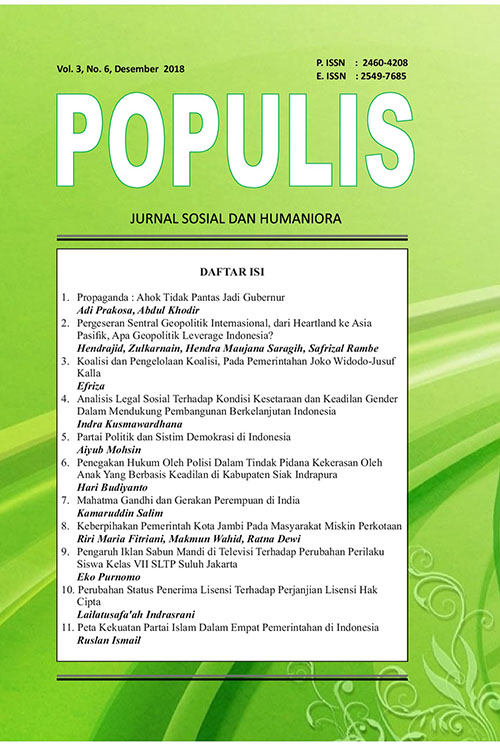PENGARUH IKLAN SABUN MANDI DI TELEVISI TERHADAP PERUBAHAN PERILAKU SISWA KELAS VII SLTP SULUH JAKARTA
DOI:
https://doi.org/10.47313/pjsh.v3i2.474Abstrak
The development of advertisement in Indonesian television media is quite fast considering the growth of electronic media also penetrated in Indonesia, the television media advertising producers do not want to miss and want to continue to be accepted in the community. Today, people especially in Indonesia are smarter in choosing what they need, therefore, the producers are competing to perform activities that are unique and interesting to keep consumers hearted.
The formulation of the problem in this research is the influence of television advertisement advertisement of lifebuoy soap to behavior change hence the purpose of this research is, to see the influence of television advertisement advertisement to the behavior change of Grade VII student of SLTP Suluh Jakarta.
The theoretical framework used in the study consists of Stimulus Theory, response organism, social learning theory and also the Hierarchy of Effect model as the basis of the difference in the effect of behavior change of each individual in seeing something that interest him.
This research is quantitative daskriptif, which aims to spread the situation or various events, and the data obtained from the population that is the students of SLTP Suluh sejumalah 56 respondents, sampling using proportional sampling which is part of probability sampling.
Based on the result of the research, the respondents of Grade VII students of SLTP Suluh Jakarta who tend to have male gender (62.5%), health soap users (53.6%) who get pocket money ≥ 300.000 per month (62.5%) that influence ad impressions television lifebuoy to behavior change Student of SLTP Suluh Jakarta is the influence of change of behavior strongly low, and influential equal to (52,5%).
Keywords: Growth of electronic media, behavior change and advertising influence.
Referensi
Bilson Simamora, Riset Pemasaran, Jakarta PT Gramedia, Pustaka Utama, 1994.
Bungin, Burhan, S.Sos., M.S, Metode Penelitian Kuantitatif, Prenada Media Group. 2005
Dendi Sudiana, Komunikasi Periklanan Cetak, Bandung, Remaja Karya 2006.
Dennis McQuail, Teori Komunikasi Massa edisi 7, Jakarta, Erlangga.
Djuarsa Sendjaja, Sasa, Teori Komunikasi, Jakarta, Pusat Penelitian Universitas Terbuka 2002.
Effendy, Onong Uchjana, Ilmu Komunikasi Teori dan Praktek, Bandung, Rosda karya, 2000.
Effendy, Onong Uchjana. Ilmu, Teori dan Filsafat Komunikasi. Bandung: Citra bakti.
Effendy, Onong, Uchjana, Ilmu Teori dan filsafat komunikasi, Bandung, Remaja Rosdakarya, 2001
Fred E. Hahn, dan Keneth G Mangun, Beriklan dan Berpromosi Sendiri, Edisi Kedua, Jakarta Grasindo, 1999.
Harjanto Rudy, prinsip-prinsip periklanan. ITKP, 2009
http://cheatonunpad.wordpress.com/2010/01/11/cuci-tangan-cara-mudah-hidup-sehat
http://skripsimahasiswa.blogspot.com/2009/12/analisa-regresi-dan-korelasi-1.html
Jalaluddin Rakhmat, Psikologi Komunikasi, Bandung, Remaja Rosdakarya, 1999.
Jefkins Frank, Periklanan, edisi ketiga, Jakarta, Erlangga, 1994.
Jenkins Fank, Periklanan, Jakarta, Erlangga, 1995.
Kotler Philip, Kevin, Lane , Keller, manajemen pemasaran. 2004
Kotler Philip, Marketing Pemasaran, the millenium editon, Upper Saddle River-New jersey: Prentice Hall Inc, 2000.
Madjadikara, S, Agus. Bagaimana biro iklan memproduksi iklan, Gramedia Pustaka Utama, Jakarta: 2004.
Mar”at”, sikap manusia perubahan serta pengukurannya,Grafindo, Jakarta. 1995.
Mardalis, Drs. Metode Penelitian, Bumi Aksara, Jakarta, 1999.
Ristiyanti P dan John J.O.I, Perilaku Konsumen, Andi Yogyakarta, Yogyakarta, 2004.
Russell,Thomas.J. Lane,Ronald.W.Kleppner’s Advertising Procedure.Prentice Hall International Editions,Printed in the USA. 2005.
Sebdaya, S Dhuarsa, Pengantar Komunikasi. Universitas Terbuka, Jakarta, 1999.
Sendjaja, S. Djuarsa, Teori Komunikasi, Universitas Terbuka, Jakarta, 1993.
Sendjaja, S.Djuarsa, Teori Komunikasi, Universitas Terbuka, Jakarta, 2001.
Sigit Santosa, Advertising Guide Book, Gramedia Pustaka Utama, Jakarta, 2002.
Sugiono, Metode Penelitian Admistrasi, Alfabet, 2005.
Sugiyono, Metode Penelitian Bisnis, Prenada Media Group, 2005.
Suprapto, Tommy. Pengantar teori dan management Komunikasi. Medpress.
Sutisna, Perilaku Konsumen dan Komunikasi Pemasaran, PT. Remaja Rosdakarya, Bandung, 2003.
Suyanto. M. Marketing strategy Top Brand Indonesia. Edisi 1, CV. Andi Offeset. Yogyakarta.
Tim pengembang ilmu pendikdikan FIP-UPI, Ilmu dan aplikasi pendidikan, Grasindo, 2007.
Urpni Lia Cristina, Sujianto Untung, Indrawati Tatik. Komunikasi kebidanan. Jakarta:Kedokteran EGC.
Werner J. Severin dan James W. Tankard. Communication Theorsies: Origin. Method and Uses. New York: Hasting S. Horse. 2007.
Winarso Puji Heru, Siologi Komunikasi Massa:Prestasi Pustaka, 2007.
##submission.downloads##
Diterbitkan
Terbitan
Bagian
Lisensi
Pemberitahuan Hak Cipta
- Hak publikasi atas semua materi informasi yang tercantum dalam situs jurnal ini dipegang oleh dewan redaksi/editor dengan sepengetahuan penulis. Pengelola Jurnal akan menjunjung tinggi hak moral penulis.
- Aspek legal formal terhadap akses setiap informasi dan artikel yang tercantum dalam situs jurnal ini mengacu pada ketentuan lisensi Creative Commons Atribusi-NonCommercial-No Derivative (CC BY-NC-ND), yang berarti bahwa hanya dengan izin penulis, informasi dan artikel Jurnal BACA dapat didistribusikan ke pihak lain dengan tanpa merubah bentuk aslinya untuk tujuan non-komersial.
- Setiap terbitan Populis Jurnal Sosial dan Humaniora, baik cetak maupun elektronik, bersifat open access untuk tujuan pendidikan, penelitian, dan perpustakaan. Di luar tujuan tersebut, penerbit atau pengelola jurnal tidak bertanggung jawab atas terjadinya pelanggaran hak cipta yang dilakukan oleh pembaca atau pengakses.




